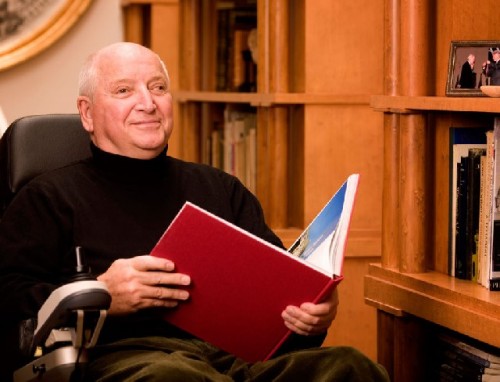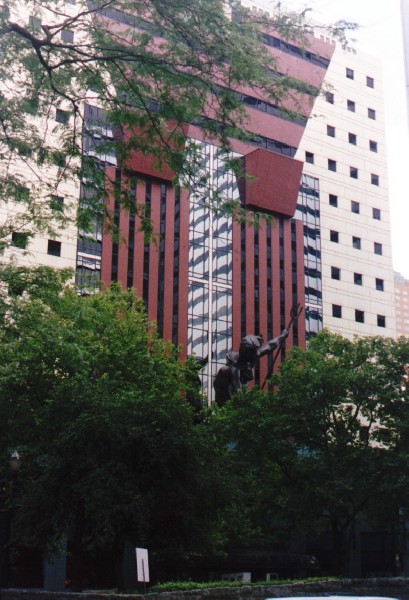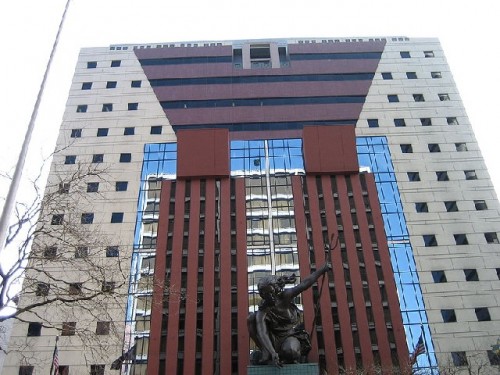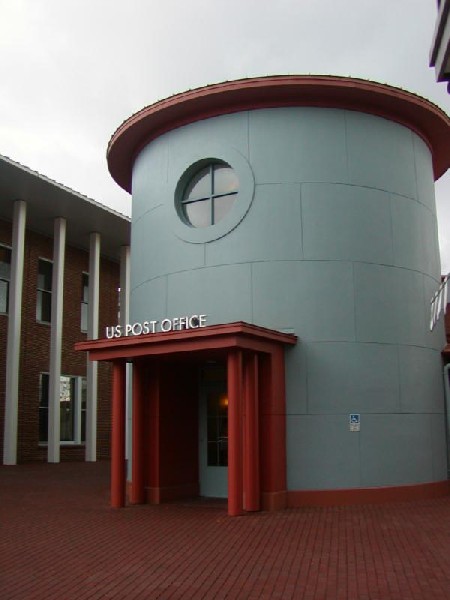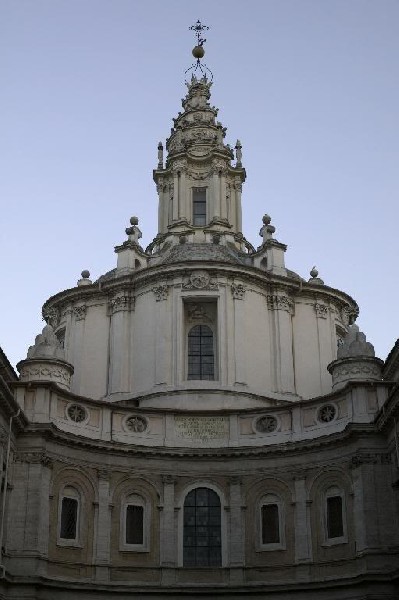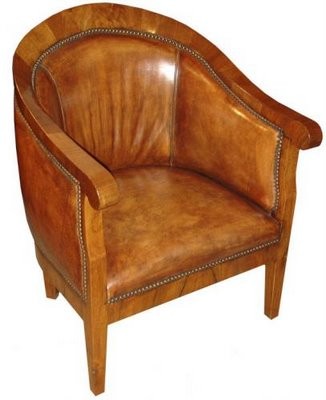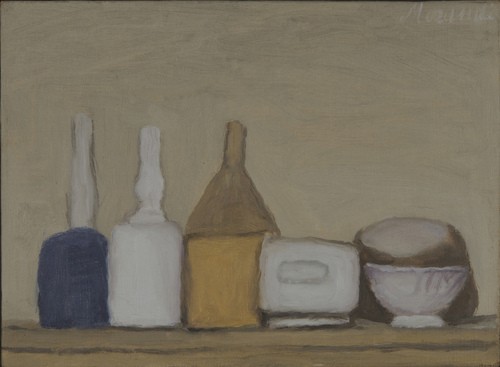Michael Graves Tells Almost All at Harvard
Superstar Architect Speaks About His Design Life
By: Mark Favermann - Oct 04, 2009
Most of the best known architects and designers are extremely articulate. They are able to explain themselves if not their particular work or projects. Michael Graves, an architectural and design icon himself for the past three decades is certainly one of these articulate architecture/design superstars. Recently, he gave a major lecture at Harvard's Graduate School of Design. It was alumni week-end (Oct. 2-3, 2009) at the Design School, and it was Graves' 50th reunion. The talk was open to the public and attended by a standing room crowd of about 400 people at Gund Hall's Piper Auditorium.Though he said nothing about his family and upbringing, he described himself as a Midwesterner from Indianapolis who had previously studied at the cooperative (work/study) architecture program at the University of Cincinnati. Graves said that the Cincinnati experience gave him the knowledge and skill to make buildings stand and not leak. Urged to go to the Graduate School of Design at Harvard by three of his former professors who had gone there themselves, he harshly stated that he learned nothing useful there. Whether this was for dramatic effect or veracity is not clear. This notion is because he went on to tell several entertaining stories about his classmates, his professors and especially one about the then Dean, Jose Luis Sert.
He took special glee in describing the distinguished but diminutive Sert as the Teeny Weeny Deany, who barely could see over the students' drawing desks. Graves criticized Sert's own architecture as well, pointing with one finger that there was a bit of color here and there. In retrospect, Sert's projects at Harvard (Peabody Terrace and Holyoke Center) and his work at Boston University including the BU Law School have not held up very well as significant architectural statements but more as period pieces. Interestingly, this may be attributed to Graves' larger works as well in the future. By the way, Sert was married to the sister of artist Joan Miro.
Graves also had harsh criticism for various of his professors who seemed almost to a man (and they were all men in those days) to have been Europeans as well as acolytes and former employees or interns for Le Corbusier. He pointed out as a Midwesterner that he was more of a Mies van der Rohe man. His lack of architectural philosophical conformity was punishable at Harvard. And Graves said that he was made to suffer for it. Dean Sert was a close friend of Le Corbusier and called Michael Graves on the carpet with threats and criticism. One professor, the Hungarian refugee Jerzy Soltan, saved him from Sert according to Graves by giving him a barely passing grade in studio.
Somehow, Michael Graves finished his masters and moved on to work for the multitalented and now iconic George Nelson's firm in New York for the next year or so focusing on factories for the Herman Miller Furniture Company, a firm that Nelson designed furniture and lighting for as well. Then Graves matter of factly stated that he applied for and was granted a Rome Prize to study in Italy. Considering his account of his less than stellar record at the GSD, it is not clear what differentiated him enough to win the Rome Prize. Perhaps, his account was not quite historically accurate, or the story was just better expressing his trials and tribulations at Harvard. It was in Rome that Graves claims to have become educated. For the next two years, he studied the Renaissance masters and hung out with art historians and artists.
In Italy, Graves was particularly taken with the work of Francesco Borromini, and he drew and painted 30 x 40" black ink sketches and washes of the master's buildings. Borromini's Baroque ornamentation influenced Graves' future work. He sold these drawings and paintings for $50 a piece. The money allowed Graves to take his Grand Tour of the ancient sites around the Mediterranean including ancient Greek and Roman significant structures and buildings. His vision and design has been influenced by the souvenir reproduction objects that 19th Century travelers could purchase on their Grand Tours. These pieces later informed his architecture as well as his consumer products. Returning to the states after two years, he was offered an architectural teaching position at Princeton University where since 1964 he taught for 40 years.
Michael Graves said that the abusive teaching methods (professors causing grown men to cry, others to faint and stomping on weeks of thoughtful drawings) at Harvard made him want to teach in a friendly more nurturing way which he hoped that he was able to do. Michael Graves is now a professor emeritus at Princeton. While at Princeton, Graves has also practiced architecture there and in New York City. His tenure at Princeton would have certainly colored his thinking and speaking about Harvard's Graduate School of Design. But those stories of abuse by bullying professors have been told by others. I liken the training to be similar to military academy hazing. You may not like the experience when you are there, but you have a certain connection and respect with all those who went before, during and after you did.
Graves' first major recognition was as one of The New York Five along with Richard Meier, Peter Eisenman, Charles Gwathmey and John Hejduk. Their work appeared (mostly unbuilt projects and family member homes) in a 1967 Museum of Modern Art exhibit and in a subsequent book, Five Architects, 1972. Their work seemed to adhere to a pure form of Modernism, but it was also connected to social and academic ideas, allegiances and philosophies. A major aspect of the group was that architect Philip Johnson was a mentor to the group. Graves spoke a bit wistfully during his Harvard talk about the recently departed Gwathmey and earlier deceased Hejduk as great architects.
In the 70's and 80's, Graves became known for his Post Modernist buildings that used flat and suggested ornamentation in theatrically dramatic ways. His Portland City Services Building (1985) is used as a major example of Post Modernism. Several other buildings including Humana's Headquarters in Louisville, Kentucky and various buildings for Disney in Florida also are examples of Graves' somewhat distinctive and perhaps period style. One wonders how these structures will be viewed 50 and 100 years from now.
Graves showed some of the early domestic objects that he was asked to design for Alessi. Initially, the pieces were highend objects that were included in museum exhibits around the United States and Japan to underscore Alessi as a brand. He told an amusing story about Nancy Regan requesting a gift of a Graves' designed tea set to the White House that the Italian owner of the company did not honor. Then he spoke with self humbling remarks about the lousy deal he wrote for the iconic bird whistle tea kettle that he designed in 1985 for Alessi. Apparently over 2 million of them have been sold, but Graves got 1.5% of each sale. The contract was never renegotiated.
Then he explained his work with Target that has brought designer items to the masses. His firm worked on the spectacular scaffolding for the renovation and repair of the Washington Monument. The construction project was sponsored by Target. The retailer, who has historically been about good design as opposed to Wal-Mart and K-Mart, then asked Michael Graves to get involved with their home products. Graves commented that they said that that they had been ripping him off for years anyway so why not just have his firm create the products?
Michael Graves has followed in the earlier tradition of the German Bauhaus and the much later French designer Philip Starck to attempt to bring well designed home products and furnishings to the masses. It appears that Graves has done it the best of all at Target with limited additions and changing products yearly and even seasonally. This may be Michael Graves' greatest design legacy, far outliving his architecture. Who can predict? But it seems right.
A lengthy review of his own Princeton house detailed his appreciation and collection of Biedermeier furniture (sleekly and richly made from 1815 to 1848), a penchant for copies of Old Master Paintings and his renovation of a Tuscan-like warehouse built by immigrant Italian craftsman for an Italian born local Princeton businessman in the early 20th century. This palazzo reflected his seminal experience at the American Academy in Rome in the early 60's. Apparently he bought the building in rundown condition in the late 60's for the bargain price of $30,000. Going through the house room by room and sometimes furniture piece by piece, he self-efacingly spoke about girlfriends leaving and two headed shower heads going half unused.
Graves has always been influenced by painting, and he showed a number of his own paintings. These were landscapes. He greatly admires Camille Corot and Giorgio Morandi. His landscape paintings are influenced by Corot; his architecture and some of his paintings seem to use the color pallet of Morandi. However, Graves is no Corot. Graves is no Morandi.
Over the years, Michael Graves' firm has done a long list of commercial, institutional and residential buildings and structures. Interior design and even custom furniture have been part of their work as well. In 1979, he was elected a Fellow of the American Institute of Architects. In 1999, Graves was awarded the National Medal of Arts. He was given the Gold Medal from the American Institute of Architects (AIA) in 2001.
In 2003, an infection of unknown origin, possibly bacterial meningitis, left Graves paralyzed from the waist down. He is still energetic and working on a number of new and future architecture projects. His firm continues its work with Target stores. Interestingly, throughout his Harvard presentation, he made reference to his paralysis and pointed out that he and painter Chuck Close both use Ibots, wheelchairs that climb stairs. Much to his chagrin, health insurance companies don't recognize the chairs as medical devices but only as transportation vehicles and therefore do not reimburse for them. With this in mind, Graves made a strong pitch for health care reform. The crowd loudly applauded.
Michael Graves has made a strong stylistic contribution to architecture. He has made a stronger one to the notion of good design in reach of everyone's budget. His legacy is clear 50 years after receiving his masters degree from the Harvard Graduate School of Design. Apparently, he did learn something there. So did we.
.

